Unlocking the Power of the 4.7 Ohm Resistor: A Comprehensive Guide
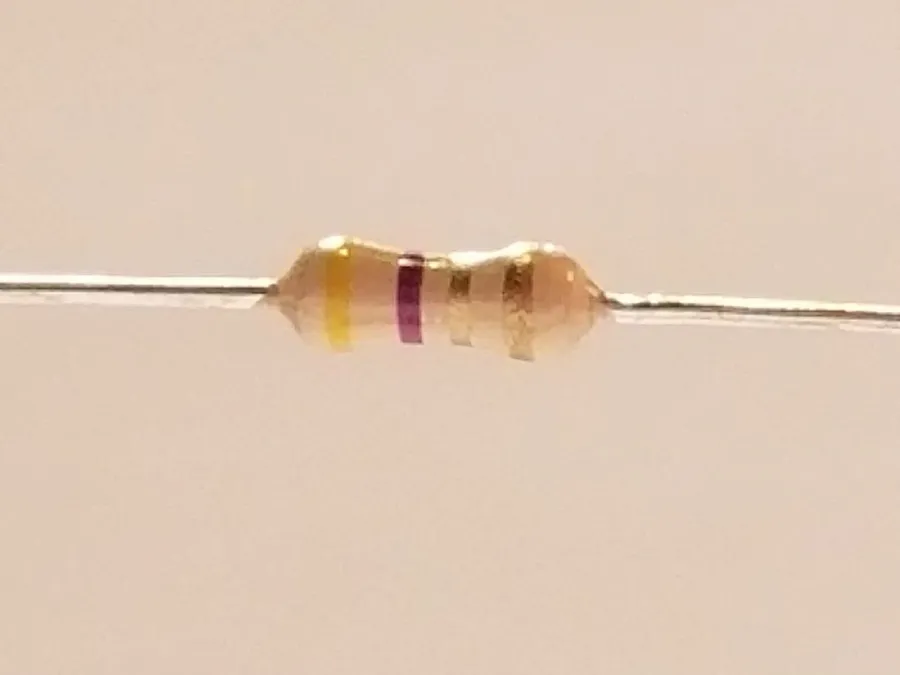
Like the silent but vital 4.7 ohm resistor in an electrical circuit, sometimes the smallest components play the biggest role. In our daily lives, from our smartphones to sophisticated electronic devices, these resistors regulate current flow. This guide will demystify the 4.7 ohm resistor, explaining its importance, variations, and practical applications, empowering you to select and use them effectively.
Understanding Resistance: The Role of a 4.7 Ohm Resistor

At the heart of electronics lies the concept of resistance, a property that opposes the flow of electrical current. The 4.7 ohm resistor, a component with a specific resistance of 4.7 ohms, serves as a crucial current regulator within circuits. By limiting the amount of current, it prevents damage to sensitive electronic components and ensures that circuits operate within their designed parameters, making it fundamental to the stability and functionality of countless electronic devices.
4.7 Ohm Resistor Color Code and Tolerance
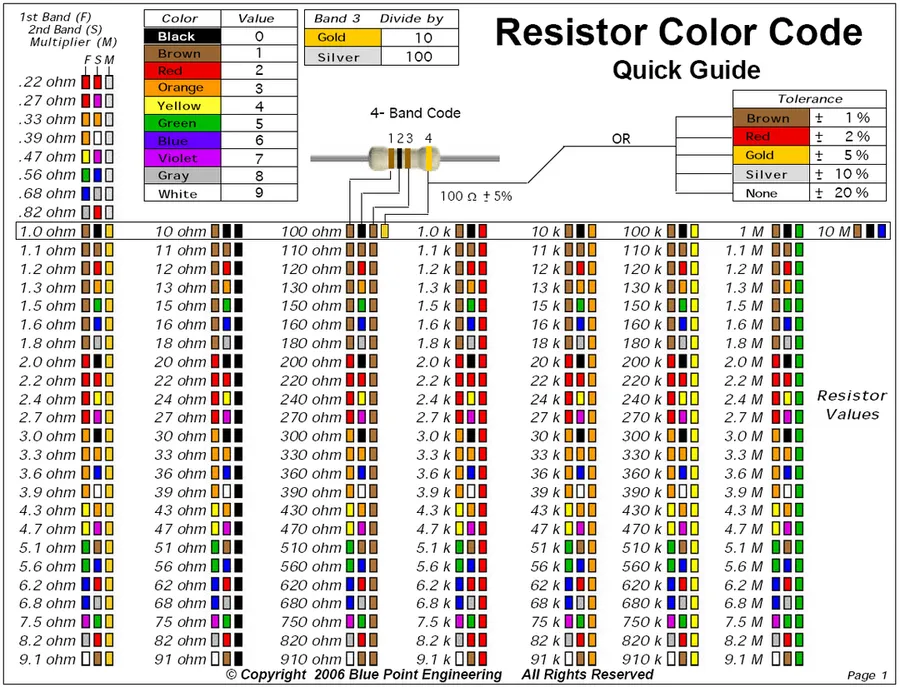
The 4.7 ohm resistor, a staple in electronics, is easily identified by its color code. This coding system allows for quick identification of the resistor's resistance and tolerance without the need for sophisticated measuring equipment. The standard color bands for a 4.7 ohm resistor are yellow, violet, gold, and gold, representing a 5% tolerance.
- Decoding the Color Bands
The color bands on a 4.7 ohm resistor are read from left to right, with the tolerance band usually being physically separated. The first band (yellow) represents the first digit, which is 4. The second band (violet) indicates the second digit, which is 7. The third band (gold) serves as the multiplier, which is 0.1 in this case. The fourth band (gold) signifies the tolerance, which is ±5%. - Calculating the Resistance
By combining the color band values, we get a resistance value of 47 x 0.1 = 4.7 ohms. This is the nominal value of the resistor. It's important to note that the order of the bands is critical for correct interpretation. - Understanding Tolerance
The tolerance of a resistor refers to the permissible deviation from its nominal resistance value. A 5% tolerance means that the actual resistance of a 4.7 ohm resistor can vary by ±5% which means that the resistor will have a value between 4.465 ohms and 4.935 ohms. This variation is acceptable for many applications, however, in more sensitive circuits, resistors with tighter tolerances are preferred. For 1% tolerance, the color band is usually brown.
| Color Band | Digit/Multiplier Value | Tolerance |
|---|---|---|
| Yellow | 4 | N/A |
| Violet | 7 | N/A |
| Gold | x0.1 | N/A |
| Gold | N/A | ±5% |
Types of 4.7 Ohm Resistors: Film, Wirewound, and More
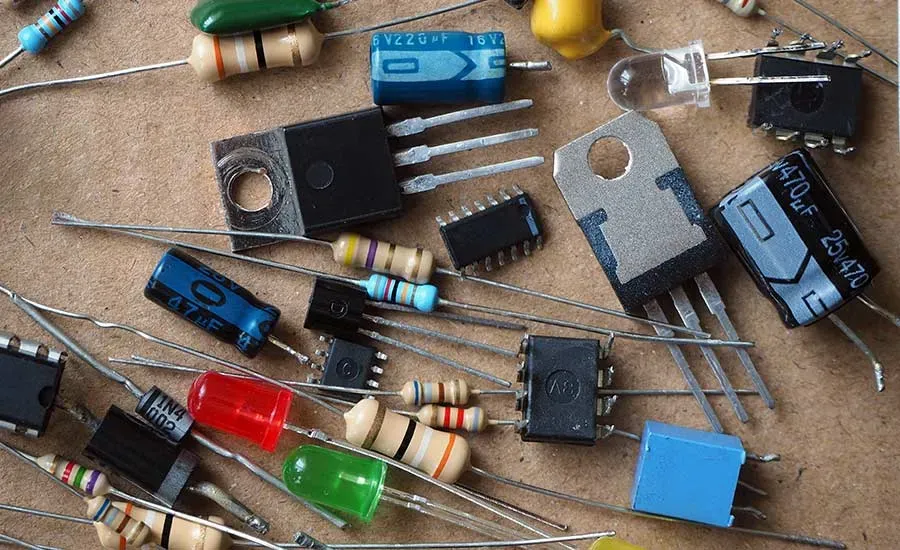
The selection of a 4.7 ohm resistor is not a one-size-fits-all decision; various types cater to different applications, each with distinct characteristics. Understanding these differences is crucial for optimal circuit design and performance. This section explores carbon film, metal film, metal oxide film, and wirewound resistors, detailing their unique properties, advantages, and typical use cases.
| Resistor Type | Construction | Typical Tolerance | Temperature Coefficient | Inductance | Typical Applications | Advantages | Disadvantages |
|---|---|---|---|---|---|---|---|
| Carbon Film | Carbon film deposited on a ceramic core | 5%-10% | High | Moderate | General purpose, low-cost applications | Low cost, readily available | High temperature coefficient, moderate noise |
| Metal Film | Thin metal alloy film deposited on a ceramic core | 1%-5% | Low | Low | Precision circuits, audio equipment | Low temperature coefficient, low noise | More expensive than carbon film |
| Metal Oxide Film | Metal oxide layer on a ceramic core | 1%-5% | Low | Very Low | High voltage, high power circuits | High temperature stability, Non-inductive | Higher cost than carbon and metal film |
| Wirewound | Wire wound around a ceramic core | 0.1%-5% | Low | High | High power applications, current sensing | High power handling capability, good precision | High inductance, large size |
Notably, metal oxide film resistors offer a distinct advantage in applications where residual inductance is undesirable, exhibiting virtually no inductive behavior. This feature is particularly valuable in high-frequency circuits where inductance can significantly affect performance. Furthermore, metal film resistors exhibit a lower temperature coefficient than carbon film resistors, making them ideal for applications requiring stability over varying temperatures. Wirewound resistors are most suitable when large power handling is needed, though, the higher inductance must be taken into account.
Power Ratings: Choosing the Right 4.7 Ohm Resistor
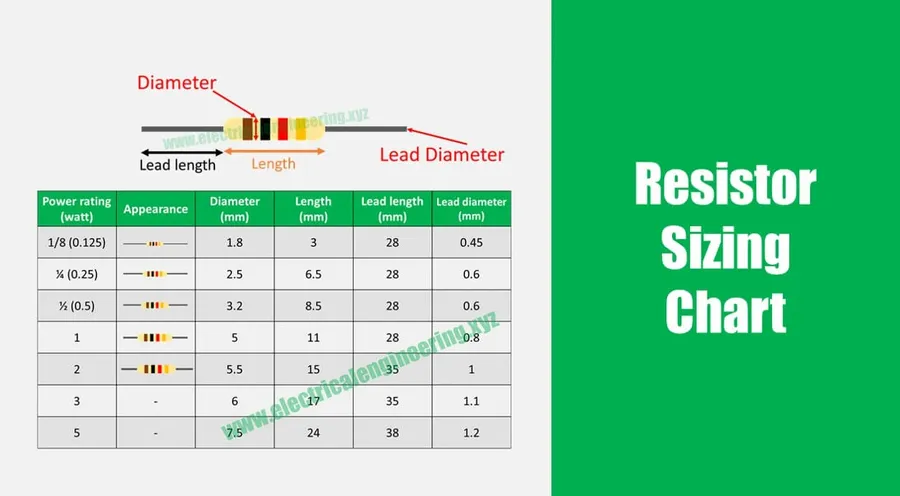
Selecting the correct power rating for a 4.7 ohm resistor is paramount for both circuit safety and optimal performance. The power rating, measured in watts (W), indicates the maximum amount of power a resistor can dissipate as heat without sustaining damage. Mismatched power ratings can lead to resistor failure, potentially causing circuit malfunction or even fire.
Resistors are available in various standard power ratings, including common values such as 1/8W, 1/4W, 1/2W, 1W, 2W, 5W, and 10W. The physical size of a resistor often correlates with its power rating, with higher wattage resistors typically being larger in size. The power rating is crucial because the electrical energy dissipated as heat, which is calculated using the formula P = I²R, needs to be managed by the resistor safely, where P is power in watts, I is current in amperes, and R is resistance in ohms.
To choose the appropriate power rating, it's essential to calculate or estimate the power dissipation in the circuit. For instance, if a 4.7 ohm resistor is expected to carry a current of 0.5A, it would dissipate power: P = (0.5A)² * 4.7Ω = 1.175W. In this scenario, selecting a 2W or 5W resistor would be necessary to ensure that the resistor is not operating near its maximum power rating. It's a good practice to choose a resistor that has a power rating significantly higher than what is calculated for the circuit to avoid overheating and premature failure.
| Power Rating | Typical Applications | Physical Size | Considerations |
|---|---|---|---|
| 1/8W (0.125W) | Low-power signal circuits, LED indicators | Very small | Good for low current, small size is a benefit |
| 1/4W (0.25W) | General-purpose circuits, basic hobby electronics | Small | Good balance of size and power handling |
| 1/2W (0.5W) | Slightly higher power circuits, audio signal paths | Medium | Handles more power than 1/4W |
| 1W | Medium power applications, power supplies | Medium to large | Suitable for moderate power dissipation |
| 2W to 5W | Higher power circuits, motor control, some power supplies | Large | Requires more board space due to larger size |
| 10W or Higher | High-power applications, heat sinks may be required | Very Large | Typically used for current control or braking resistors |
4.7 Ohm Resistors in Different Applications
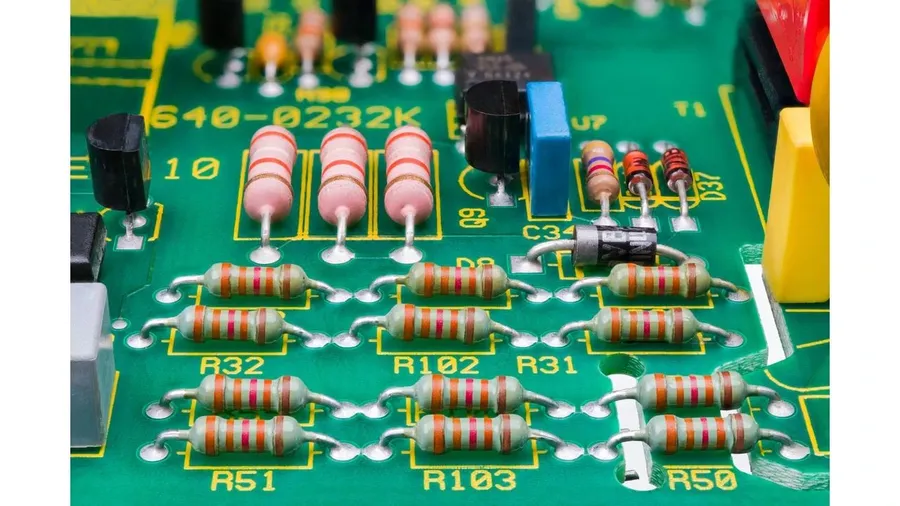
The 4.7 ohm resistor, while seemingly simple, plays a crucial role in diverse electronic applications. Its primary function is to regulate current flow, preventing damage to sensitive components and ensuring circuits operate as intended. This section explores its practical uses in audio circuits, LED circuits, and power supplies, as well as its behavior in series and parallel configurations.
- Audio Circuits (Speaker Crossovers)
In audio systems, 4.7 ohm resistors are used in speaker crossover networks. These networks separate audio frequencies, directing low frequencies to woofers and high frequencies to tweeters. The resistor helps to control the impedance of the crossover, ensuring the optimal performance of the speakers and preventing signal distortion or loss, working together with capacitors and inductors. The choice of resistor depends on the power handling requirement of the speaker system. - LED Circuits
LEDs require current-limiting resistors to prevent them from drawing excessive current, which can lead to overheating and premature failure. A 4.7 ohm resistor is often used in LED circuits to regulate the current through the LED, ensuring that it operates within its safe current range, extending the life of the LED. The specific resistance value will depend on the LED’s forward voltage and the power supply voltage, with 4.7 ohms often used in standard circuits with a 5V supply. - Power Supplies
In power supplies, 4.7 ohm resistors can be used as current-sensing resistors, which allows the measurement of the current flowing through a circuit. By measuring the voltage drop across the resistor (using Ohm's Law, V=IR), the current in the circuit can be determined. In this case, 4.7 ohms can provide a reasonably measurable voltage drop for common current levels, being a good trade-off between the voltage signal and power consumption. - Series and Parallel Configurations
Resistors can be connected in series or parallel configurations, and understanding these setups is crucial in circuit design. When in series, the total resistance increases. For example, two 4.7 ohm resistors in series will result in a total resistance of 9.4 ohms (4.7 + 4.7). Conversely, when in parallel, the total resistance decreases. Two 4.7 ohm resistors in parallel will result in a total resistance of 2.35 ohms (4.7 / 2), calculated using the parallel resistance formula: 1/R_total = 1/R1 + 1/R2 + ... and then inverting the result. These configurations allow for flexibility in circuit design, enabling engineers to achieve specific resistance values not available with a single resistor.
Where to Buy 4.7 Ohm Resistors: A Practical Guide
Securing the correct 4.7 ohm resistor for your project is essential, and several options are available, ranging from large online marketplaces to specialized electronics suppliers. This section provides practical advice on where to purchase these components, and what to consider before making a purchase.
- Online Retailers
Major online marketplaces like Amazon, eBay, and others offer a vast selection of 4.7 ohm resistors. These platforms often provide competitive pricing and convenient shipping options. However, verifying the seller's reputation is crucial. - Specialized Electronics Stores
Retailers like Adafruit, SparkFun, and Digi-Key are dedicated to electronic components. They typically offer higher-quality parts, detailed specifications, and robust customer support. - Direct from Manufacturers
For large-scale projects, consider purchasing directly from component manufacturers or their authorized distributors to ensure authenticity and potentially better pricing. - Potential Pitfalls: Aliexpress
While platforms like Aliexpress may offer attractive pricing, the quality and accuracy of the components can be inconsistent. It's crucial to exercise caution and verify the seller's reliability.
When purchasing 4.7 ohm resistors, several factors should be taken into account to ensure you are buying the right part.
- Wattage Rating
Ensure the resistor's power rating matches or exceeds your circuit's requirements. Common ratings are 1/8W, 1/4W, 1/2W, 1W and larger, depending on the application. Choosing a resistor with too low of a wattage rating can cause the resistor to fail, while using a resistor with a much higher wattage rating will not cause harm, but can increase the cost and size of the resistor. - Tolerance
The tolerance of a resistor indicates how close to the specified value the actual resistance will be. Common tolerance values are 5% (gold band) or 1% (brown band). If the design is sensitive to the exact resistance value, it is better to select a 1% tolerance resistor. - Quantity
Purchase sufficient quantities for your project, including spares to account for any errors during assembly or testing. Buying in bulk may result in cost savings, particularly for larger projects. - Type
The different types of resistors available, such as carbon film, metal film, wirewound and others will each have their use cases. Select the type that best matches your project.
Troubleshooting and FAQs for 4.7 Ohm Resistors
This section addresses common issues encountered with 4.7 ohm resistors and provides solutions. Additionally, it clarifies frequently asked questions regarding their usage and specifications, ensuring a comprehensive understanding for practical applications.
- What is a 4.7k ohm resistor used for?
A 4.7k ohm resistor (4,700 ohms) is used for significantly different purposes than a 4.7 ohm resistor. It's commonly found in applications requiring higher resistance, such as pull-up or pull-down resistors in digital circuits, feedback paths in amplifier circuits, or in timing circuits. The 'k' denotes a multiplier of 1000 (kilo-ohms). - What does '4R7' mean on a resistor?
'4R7' is an alternative way to write 4.7 ohms. The 'R' is used as a decimal point, allowing for a more compact notation, particularly when printing on small components. It indicates the same resistance value as 4.7 ohms. - What are common signs of a failed 4.7 ohm resistor?
A failed resistor can exhibit several symptoms, including discoloration or charring due to overheating, an open circuit (infinite resistance), or a significant shift in resistance value. These failures can be caused by excessive current, voltage surges, or environmental factors. - How can I test a 4.7 ohm resistor?
A digital multimeter (DMM) is the standard tool for testing resistance. Set the DMM to the ohm setting (Ω) and measure across the resistor's terminals. The reading should be close to 4.7 ohms, within the resistor's tolerance (e.g., ±5%). - What happens if the wrong wattage is used for the 4.7 ohm resistor?
Using a resistor with insufficient power rating will cause it to overheat, potentially leading to failure, circuit damage, or even fire hazards. It is crucial to always use a resistor rated for at least the power it will dissipate in the circuit with a safety margin. - Can a 4.7 ohm resistor be replaced with a different value?
Replacing a 4.7 ohm resistor with another value will change the electrical behavior of the circuit. Always aim for the same or very similar resistance value to maintain circuit design intentions. If different values are used, they should be calculated to have the equivalent intended circuit behavior. - Why is my 4.7 ohm resistor overheating?
Overheating indicates the resistor is dissipating more power than it is rated for, which is a failure mode. Common reasons are excessive current flowing through the resistor, often caused by a downstream fault or an incorrect circuit design. It is critical to check the circuit for faults.
Comparative Analysis: Different Types of 4.7 Ohm Resistors
Selecting the appropriate 4.7 ohm resistor requires a careful evaluation of various types, each with distinct characteristics, applications, and cost implications. This section provides a comparative analysis, emphasizing practical advice to guide the user in choosing the optimal resistor for their specific needs. Understanding the nuances between metal film, carbon film, and wirewound resistors is crucial for effective circuit design and functionality.
| Characteristic | Metal Film Resistor | Carbon Film Resistor | Wirewound Resistor |
|---|---|---|---|
| Resistance Tolerance | Typically 1% or 5% | Typically 5% or 10% | Typically 1% to 5% |
| Temperature Coefficient | Low, typically ±50 ppm/°C | Moderate, typically ±250 ppm/°C | Low, typically ±100 ppm/°C |
| Power Rating | Low to medium (e.g., 1/8W, 1/4W, 1/2W, 1W) | Low to medium (e.g., 1/4W, 1/2W, 1W) | Medium to High (e.g., 1W, 3W, 5W, 10W or higher) |
| Stability | High stability with low noise | Moderate stability with higher noise | High stability and low noise, but can be inductive |
| Typical Applications | Precision circuits, audio amplifiers, instrumentation | General-purpose applications, low-cost electronics | High-power applications, power supplies, braking resistors |
| Cost | Moderate | Low | Moderate to High |
| Pros | High precision, low noise, stable performance. | Low cost, suitable for general use. | High power handling, robustness |
| Cons | More expensive than carbon film resistors | Lower precision, higher noise, sensitive to temperature variations. | May have some inductance, higher cost, typically larger size. |
Practical Advice: For precision circuits, such as those found in instrumentation or audio amplifiers, a metal film resistor with its low tolerance and temperature coefficient is preferred. For general purpose applications with less stringent requirements, a carbon film resistor is a cost effective solution. In high-power applications, such as power supplies or motor controllers, a wirewound resistor is the best option. When choosing between 1/8W metal film or a 10W wirewound resistor, the primary factor should be the power demands of the circuit; using a resistor under its rated power value ensures reliability. Remember that the tolerance directly impacts performance, especially in circuits where small variations in resistance can be critical.
Advanced Considerations: Temperature Coefficient and Precision
For advanced applications, understanding the temperature coefficient and precision of a 4.7 ohm resistor is crucial. These factors significantly impact circuit performance, especially in sensitive or high-performance electronics. Selecting the correct resistor with respect to these factors ensures circuit stability and optimal functionality.
The temperature coefficient of a resistor quantifies how its resistance changes with temperature variations, typically expressed in parts per million per degree Celsius (ppm/°C). For example, a resistor with a temperature coefficient of +100 ppm/°C will increase its resistance by 0.01% for every 1°C rise in temperature. Different resistor types have different temperature coefficients. Metal film resistors generally exhibit a lower temperature coefficient than carbon film resistors, making them the preferable option for environments with fluctuating temperatures. Wirewound resistors, while capable of handling higher power, can also have higher temperature coefficients, and may not be suitable for sensitive circuits where temperature stability is critical. The selection of a resistor based on its temperature coefficient is key to maintaining predictable circuit performance.
Tolerance, usually expressed as a percentage (e.g., 1% or 5%), indicates the allowable deviation of a resistor’s actual resistance from its stated value. In precision circuits, such as those found in medical devices or scientific instrumentation, a 1% tolerance resistor is often required to meet stringent accuracy requirements, since the resistor value is within a smaller deviation from the nominal value. In contrast, 5% tolerance resistors are generally suitable for less critical applications where a small variation in resistance has a negligible impact on the circuit operation, such as in some LED circuits. Selecting the appropriate tolerance is important to balance cost with circuit accuracy requirements.
The physical assembly of a resistor in a circuit also plays a role. Through-hole resistors, with their wire leads, are inserted into circuit boards and are ideal for prototyping and low-volume production. Surface Mount Devices (SMD) resistors, are smaller and are soldered directly onto the surface of circuit boards and are much better for high density and automated assembly. In precision circuits, SMD resistors are generally preferred for their smaller size, and improved performance characteristics, such as lower parasitics, compared to through-hole counterparts, making them suitable for modern miniaturized electronics. Choosing between SMD and through-hole resistors is generally dictated by the application requirements and assembly process.
The humble 4.7 ohm resistor, often overlooked, is essential to electronics, like a well-balanced musical note. From regulating current to optimizing audio output, its correct application is key. Remember, choosing the right type, power rating, and tolerance is critical for success. Just like how a 4.7 ohm resistor provides the right resistance, with proper knowledge, any electronics project can be just right.
 AnyPCBA
AnyPCBA